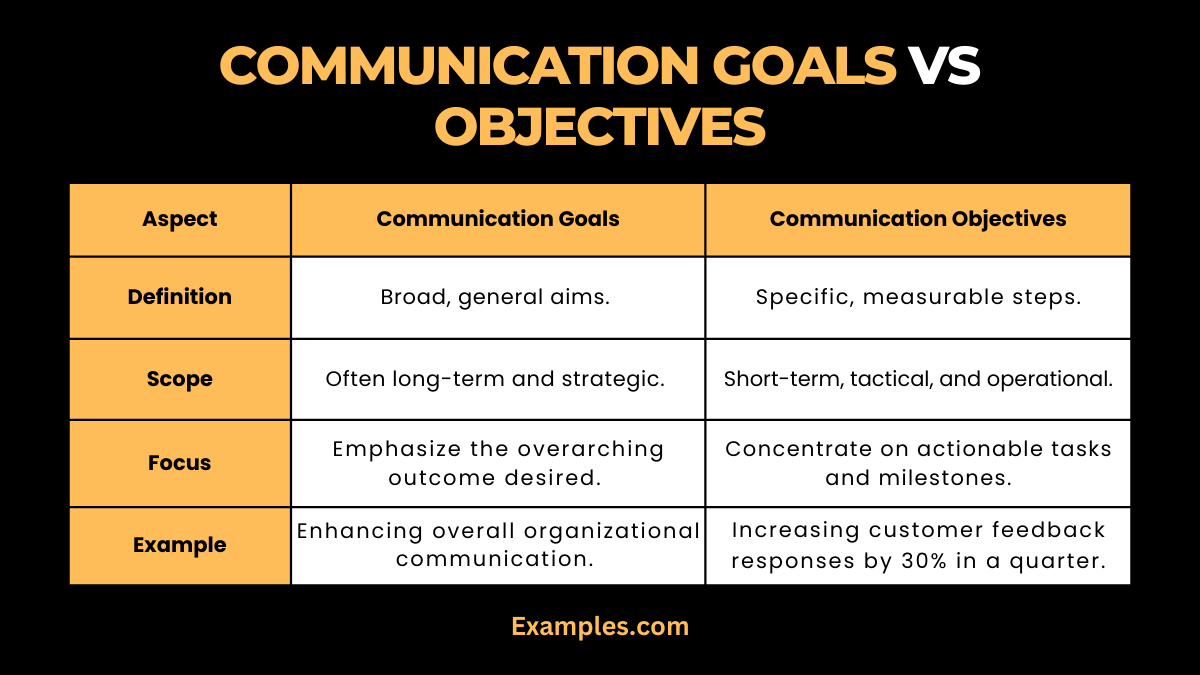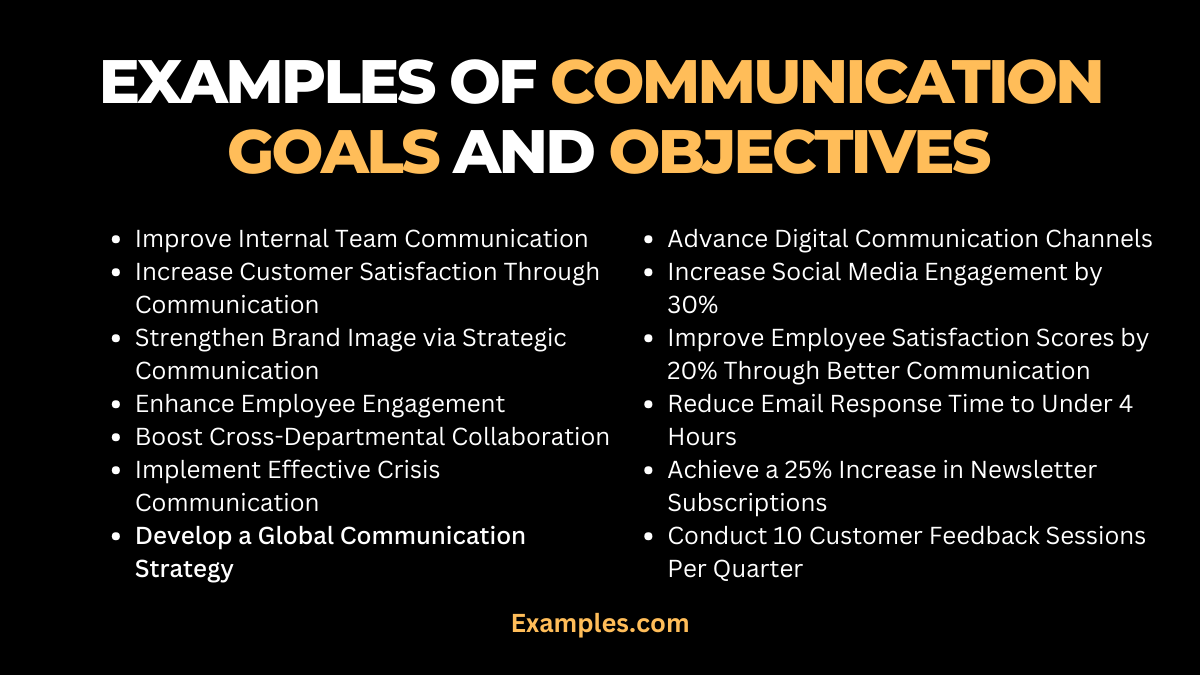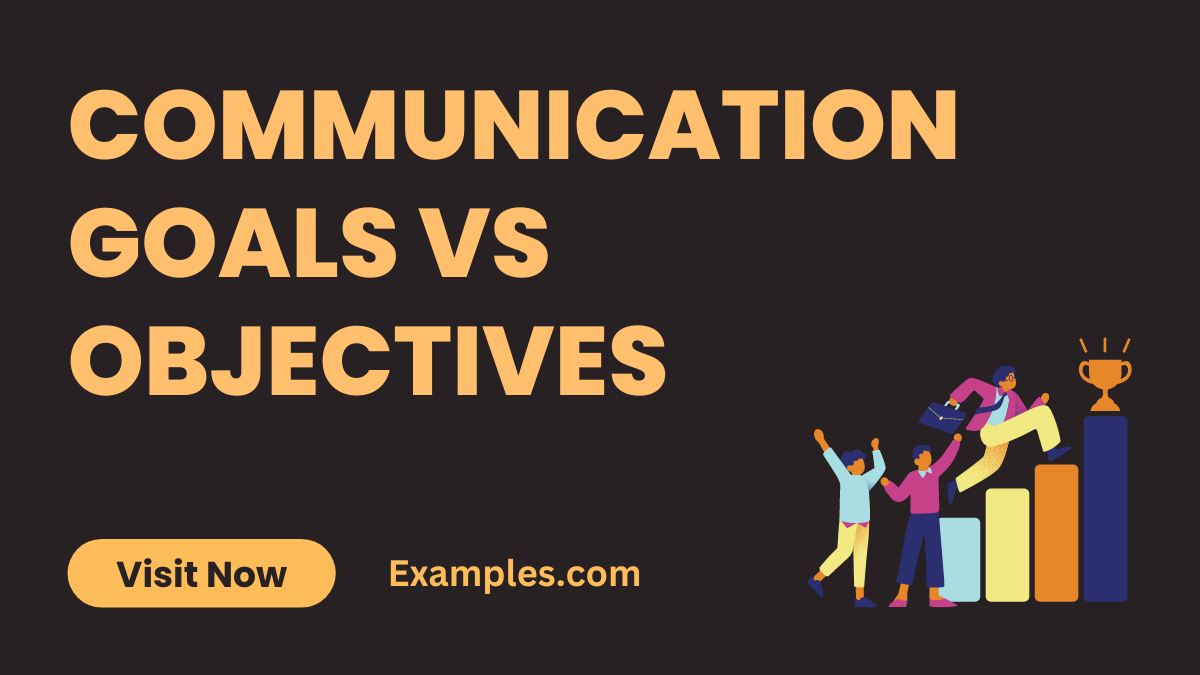Communication Goals vs Objectives – 19+ Examples
In the realm of communication, setting communication goals is a foundational step for any individual or organization. These goals are broad, overarching aims that encapsulate the desired outcomes of communication efforts. They are often qualitative, providing a general direction rather than specific benchmarks. A typical communication goal might be to enhance brand awareness or improve public perception, which outlines the broader vision but doesn’t delve into the specifics of how to achieve it.
Download Communication Goals PDF
Download Communication Objectives PDF
Difference Between Communication Goals vs Objectives

On the other hand, communication objectives are the specific, measurable steps that help in achieving these broad goals. They are more concrete and quantifiable, making it easier to track progress and success. Examples of communication objectives include Awareness Building Communication Objective, which aims to increase the visibility of a brand or message, and Information Dissemination Communication Objective, focused on spreading key information to a target audience.
| Aspect | Communication Goals | Communication Objectives |
|---|---|---|
| Definition | Broad, general aims. | Specific, measurable steps. |
| Scope | Often long-term and strategic. | Short-term, tactical, and operational. |
| Focus | Emphasize the overarching outcome desired. | Concentrate on actionable tasks and milestones. |
| Nature | Qualitative and often abstract. | Quantitative and concrete. |
| Example | Enhancing overall organizational communication. | Increasing customer feedback responses by 30% in a quarter. |
| Measurement | Difficult to measure directly; requires indirect assessment. | Easily measurable through specific criteria. |
| Purpose | Sets the overall direction for communication efforts. | Provides clear, step-by-step actions to achieve goals. |
| Flexibility | Typically more flexible and adaptable. | More rigid, requiring specific outcomes. |
| Formulation | Based on the organization’s vision and mission. | Derived from the communication goals, tailored to specific needs. |
| Time Frame | Longer-term, can span years. | Shorter-term, often set for specific periods (monthly, quarterly). |
This table succinctly outlines the key differences between communication goals and objectives. Goals set the direction and purpose, while objectives lay out the path to achieve these goals. Other types include Persuasion Communication Objective, aiming to sway public opinion or decision-making, and Brand Reinforcement Communication Objective, which seeks to strengthen a brand’s image in the minds of consumers.Understanding this distinction is essential for any successful communication strategy, whether in a business setting or personal interactions.
10 Communication Goals Examples

Setting clear communication goals is fundamental for achieving effective and efficient interactions in any organization. To effectively utilize these concepts, it’s important to know How to Write a Communication Objective? and How to Determine Communication Objectives? These goals range from improving team dynamics to enhancing customer engagement. They form the backbone of a strategic communication plan, guiding the overall direction and purpose of your communication efforts.
- Improve Internal Team Communication: Enhance the clarity and frequency of communication within teams.
Example: “Let’s ensure we have weekly team meetings to discuss project updates and address any concerns.” - Increase Customer Satisfaction Through Communication: Use communication to boost customer experience and satisfaction.
Example: “We aim to respond to customer inquiries within 24 hours to improve their experience with our brand.” - Strengthen Brand Image via Strategic Communication: Enhance the company’s public image through consistent and positive messaging.
Example: “Our goal is to align all our communications with our core brand values to build a stronger brand image.” - Enhance Employee Engagement: Foster a communicative environment that encourages employee participation and feedback.
Example: “We encourage all team members to actively participate in our monthly town hall meetings.” - Boost Cross-Departmental Collaboration: Promote effective communication across different departments.
Example: “Let’s have cross-departmental meetings every quarter to ensure alignment and collaboration.” - Implement Effective Crisis Communication: Develop a clear communication strategy for handling crises efficiently.
Example: “In times of crisis, our goal is to communicate transparently and promptly to all stakeholders.” - Cultivate a Customer-Centric Communication Approach: Focus on tailoring communication to meet customer needs and preferences.
Example: “Our communications should always consider the customer’s perspective and address their needs.” - Promote Open and Transparent Leadership Communication: Ensure leadership communication is open and transparent to build trust.
Example: “Leaders should regularly share company updates and future plans with all employees.” - Develop a Global Communication Strategy: Create a communication strategy that addresses the needs of a global audience.
Example: “We need to consider cultural nuances in our global communication strategy to effectively reach our international audience.” - Advance Digital Communication Channels: Modernize and improve the use of digital platforms for communication.
Example: “Let’s leverage social media and our website more effectively to engage with our audience.”
10 Communication Objectives Examples
Crafting specific communication objectives Examples is essential for achieving your broader communication goals. These objectives provide a road map with measurable, actionable steps. The Importance of Communication Objectives cannot be overstated, as they provide a clear pathway to achieving communication goals.From enhancing team collaboration to refining customer interaction, setting precise objectives can significantly impact the effectiveness of your communication strategy.
- Increase Social Media Engagement by 30%: Aim to boost interaction on social media platforms.
Example: “Our objective is to increase likes, comments, and shares on our social media posts by 30% in the next six months.” - Improve Employee Satisfaction Scores by 20% Through Better Communication: Focus on enhancing internal communication to increase employee satisfaction.
Example: “We will conduct bi-weekly feedback sessions to understand and address any communication issues, aiming to improve satisfaction scores.” - Reduce Email Response Time to Under 4 Hours: Streamline communication processes to respond to emails more efficiently.
Example: “Our team should aim to reduce our average email response time to less than four hours.” - Achieve a 25% Increase in Newsletter Subscriptions: Use effective communication strategies to grow the newsletter subscriber base.
Example: “We will revamp our newsletter content and sign-up incentives to achieve a 25% subscription increase.” - Conduct 10 Customer Feedback Sessions Per Quarter: Regularly engage with customers to gather valuable feedback.
Example: “We plan to conduct at least 10 feedback sessions with customers every quarter to better understand their needs.” - Implement Monthly Team Building Activities to Improve Team Communication: Use team-building exercises to foster better communication among team members.
Example: “Our objective is to hold monthly team-building activities to enhance team cohesion and communication.” - Develop and Launch an Internal Communication App within 6 Months: Introduce new technology to improve internal communication.
Example: “We aim to develop and launch a user-friendly internal communication app in the next six months.” - Decrease Miscommunication Incidents by 40% in Project Teams: Work on strategies to reduce misunderstandings within project teams.
Example: “Our objective is to provide additional training and clarify communication protocols to reduce miscommunication incidents.” - Increase Participation in Employee Surveys by 50%: Encourage more employees to partake in surveys for better feedback.
Example: “By improving our communication about the importance of surveys, we aim to increase participation rates by 50%.” - Enhance Client Retention Rate through Improved Communication: Use effective communication to maintain and grow the client base.
Example: “Our goal is to enhance our client communication, aiming to improve the client retention rate significantly.”
Comparison & Relationship Between Communication Goals vs Objectives
In the realm of communication, goals and objectives play distinct yet interconnected roles. Communication goals are broad, overarching aims like enhancing organizational rapport or client satisfaction. For instance, a goal might be to improve team efficiency, while an objective could be conducting weekly team briefings.
- Purpose and Direction:
Goals set the overall purpose and direction for communication efforts, like enhancing brand reputation or improving team interaction.
Objectives, however, provide specific actions and benchmarks to achieve these goals, such as increasing social media engagement or reducing internal email response time. - Scope and Specificity:
Goals are broad and may encompass the entire organization, lacking specific details.
Objectives are narrow in scope, offering detailed plans and clear steps, like achieving a certain percentage increase in customer feedback or organizing a set number of team-building activities. - Time Frame:
Goals often have a longer-term perspective, aiming for outcomes over years.
Objectives are shorter-term, set for specific periods like quarterly or annually, with clear deadlines. - Measurability:
Goals are generally qualitative and harder to measure directly, like improving communication culture. Objectives are quantitative and easily measurable, such as attaining a specific target in audience growth or employee engagement scores. - Flexibility vs Rigidity:
Goals tend to be more flexible, allowing adjustments as the organization evolves.
Objectives require more rigidity, demanding adherence to specific criteria to ensure they are met within the designated time frame. - Strategic vs Tactical:
Goals are strategic, aligning with the organization’s vision and long-term plans.
Objectives are tactical, focusing on the execution of strategies to meet these larger goals, often involving specific communication tasks or projects.
Strategic Communication Goals and Objectives
Strategic communication Objectives And goals are integral to any business’s success. Goals here often focus on long-term vision and impact, such as establishing strong brand presence or fostering positive stakeholder relations. Objectives, in turn, are precise, tactical steps like implementing regular stakeholder communication channels or developing a targeted marketing campaign, all aimed at fulfilling these strategic goals.
- Aligning with Business Vision: Strategic communication goals should align with the overarching business vision, ensuring that every communication effort contributes to the broader objectives of the organization.
- Stakeholder Engagement: These goals focus on engaging various stakeholders, including employees, customers, and partners, ensuring that communication is tailored to their needs and perspectives.
- Brand Consistency: Maintaining a consistent brand message across all communication channels is a key strategic goal, reinforcing the organization’s identity and values.
- Crisis Management: Developing proactive communication strategies for potential crises, ensuring the organization can respond swiftly and effectively in challenging situations.
- Feedback Mechanisms: Incorporating feedback mechanisms to gauge the effectiveness of communication strategies and make necessary adjustments.
- Technology Utilization: Leveraging the latest communication technologies and platforms to enhance reach and impact.
- Cultural Sensitivity: Ensuring communication strategies are culturally sensitive and inclusive, particularly for global organizations.
SMART Communication Goals and Objectives in Business
SMART communication goals and objectives in business are specific, measurable, achievable, relevant, and time-bound. In a business setting, Communication Objectives in Business and Communication Objectives in an Organization are vital for ensuring all stakeholders are aligned with the company’s mission and goalsA SMART goal might be to increase market share by 10% within a year, while an objective could involve launching a new advertising campaign or enhancing customer service protocols to directly contribute towards this goal, ensuring they are measurable and time-specific.
- Specific: Goals and objectives should be clear and specific, making it easier to focus efforts and feel truly motivated to achieve them.
- Measurable: Set measurable goals and objectives to track progress and stay motivated, understanding the distance to the goal and when it has been achieved.
- Achievable: Goals should be realistic and attainable to be successful.
- Relevant: Ensure that your goals matter to you and align with other relevant goals.
- Time-bound: Every goal needs a target date, so that you have a deadline to focus on and something to work toward.
- Adaptability: Being flexible to adapt goals as business environments and priorities change.
Difference Between Goals and Objectives in Public Relations
In public relations, the difference between goals and objectives is critical. Goals are broad targets like improving a company’s public image or reputation. These objectives can be tailored to different contexts, like Communication Objectives for Resume, where the focus is on showcasing communication skills to potential employers, or Communication to Stakeholders Objective, which is key in maintaining transparent and effective communication with key stakeholders.Understanding this distinction is key to effective PR strategy implementation.
- Vision vs Execution: Goals in public relations often represent the vision (like improving brand image), while objectives are about execution (like increasing press mentions by 20%).
- Broad vs Specific: Goals are broad targets, while objectives are specific milestones towards achieving these goals.
- Qualitative vs Quantitative: Goals in PR are often qualitative, whereas objectives are quantitative and measurable.
- Long-term vs Short-term: Goals are generally long-term aspirations, while objectives are short-term targets.
- Guiding Principles vs Tactical Steps: Goals provide guiding principles for PR strategies, whereas objectives outline the tactical steps to achieve these goals.
By understanding and effectively setting both communication goals and objectives, organizations and individuals can ensure that their communication strategies are not only purposeful but also measurable and achievable. This distinction is also reflected in the differences between Communication Goals vs Objectives, Communication Objectives vs Measurements, and Communication Objectives vs Marketing Objectives. Each plays a unique role in crafting a comprehensive and effective communication plan. Harvard Business School Online explains that business goals and objectives dictate how a company plans to achieve its goal



